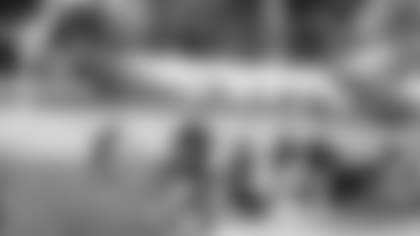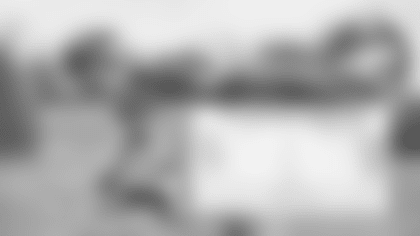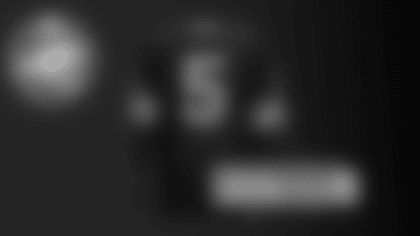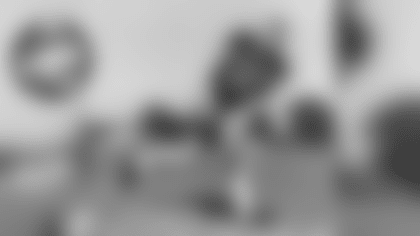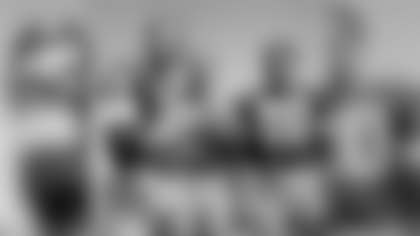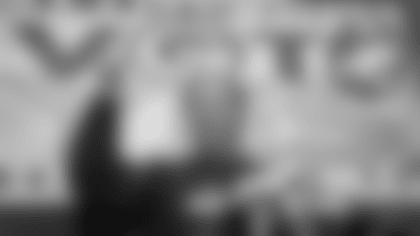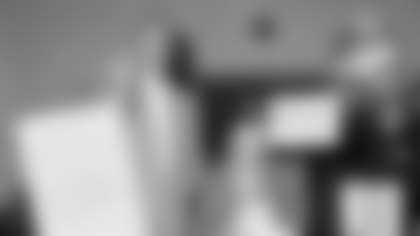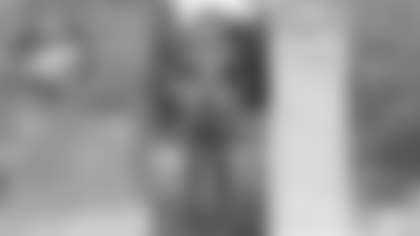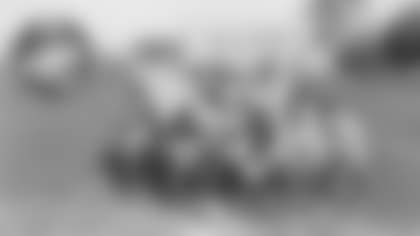Ron from Appleton, WI
When were the first face masks used on the Packer helmets? I am guessing sometime in the early 1950s probably, but could not really find when it was. Was there any particular Packer player or group of players (like linemen or halfbacks) that were the first to use them before it spread to the rest of the team?
Sorry, if you don't remember asking this question. It was one of several you submitted in an email almost seven years ago, shortly after I became Packers historian. I still had it in my inbox because I don't delete the good ones, or at least the questions that intrigue me. One reason I never answered is because I've saved bits and pieces of research on the subject and have asked that question of players from the late Curly Lambeau and early Gene Ronzani years, but never thought I could provide a definitive answer. I considered my research open-ended and still do. However, it's certainly a relevant topic at the moment with Heritage Auctions offering a gold Packers helmet with what it describes as a "cow catcher" facemask at a price of $15,000 or more. First, I'm not an authority on Packers memorabilia so I'm in no position to guarantee anything, but this is a case where history at least coincides with the item. The only thing I'd note is that it could be a 1950 helmet, rather than one from the 1940s, just because there were more players – maybe several more – wearing face guards that year. Here's what I can tell you about those early guards, which is what they were called back then. The first reference I've found to a Packers player wearing one was end Carl Mulleneaux in 1946, but only in practice. In the season opener that year against the Bears, he was the victim of a career-ending cheap shot that knocked him out cold for 10 minutes or more, and left him with at least three dislocated vertebrae, a concussion, a broken nose, facial cuts and three broken teeth. He tried to come back later in the season and wore a face guard in practice to protect his nose, but he never played again. A year later, in 1947, back Herman Rohrig wore a face guard against the Bears to protect a broken nose he had sustained two weeks earlier. So far, from what I've found, he may have been the first Packer to wear one in a game. Three weeks earlier, Fred Boensch, a guard with Washington, wore a vertical bar in front of his nose while playing against the Packers. He wore a special headgear during his two-year career to protect a shattered jaw he suffered as a Marine during fighting in the Pacific front during World War II. Thus, when you asked what particular players wore them first, I think the answer would be this: players with broken noses or other facial injuries. There also must have been several other players in the league wearing what were steel face guards by then because Dr. George Bennett, a Baltimore surgeon who had treated several famous athletes, declared at the end of the 1947 season that they should be banned. He argued the guards were being used like "armor" and were an "open invitation to crush someone's jaw or knock his teeth out." In 1948, the Green Bay Press-Gazette carried a photo following the Packers-Bears game at Wrigley Field showing three Bears wearing face guards. Not sure if any Packers were wearing any, but tackle Paul Lipscomb was not. Early in that mid-November game, the Bears' Fred Davis, a pro wrestler in the offseason, twice smacked Lipscomb in the mouth, drawing blood and making a mess of his lip. Later, Davis elbowed Lipscomb in the face before Lipscomb finally retaliated and threw a punch at him on the next play. As a result, Lipscomb was ejected, but not Davis. In the 1949 opener at City Stadium, Lipscomb wore a face guard. In explaining why, the Press-Gazette's Art Daley wrote, "It can be recalled that Davis left Lipscomb's face a mass of raw beef steak in the game at Chicago last fall." Daley also noted that the Packers' 300-pound center Ed Neal wore a face guard in that game, as well. Three weeks later, Daley wrote that Lipscomb was "playing with a face guard consistently." Considering Daley had started covering the Packers in 1941, that sentence suggests to me that Lipscomb might have been the first to wear one regularly. The Press-Gazette also ran a photo the day after the Packers-Bears rematch in Chicago in early November 1949, showing Lipscomb wearing a face guard, much like the one being sold at the Heritage Auction site. In 1950, the Packers and Bears met at City Stadium on Oct. 1, and the Press-Gazette ran several photos showing a number of Packers wearing face guards. Avid Packers fan and collector Mark Schneider also sent me a close-up photo of tackle Ed Ecker wearing a face guard and standing on the sideline next to Ronzani, the new Packers coach. By 1951, I've found several photos with a number of Packers wearing them, including end Bob Mann, their first African-American player, who was frequently the target of cheap shots and punches to his face. That was the year George Halas offered bonus money before the game in Chicago to the first player on his team "who could knock the moustache off Mann." Years later, some of Mann's teammates distinctly remembered him wearing a face guard, which suggests to me he might have been the first to wear one over several seasons. But he played in only the last three games in 1950 and I've yet to find any evidence that he wore one in those games. I think he started wearing one in 1951 and guard Ray DiPierro, who played in 1950-51, once told me the Packers purchased different – not new, but second-hand – helmets in his second season and the players themselves painted them gold. Although the Packers might have worn their old helmets in the preseason in 1951, I don't believe the helmet being auctioned was from that season. Is it possible to determine who wore the helmet posted at the Heritage site and in what year? If the number "80" is written in the inside as Heritage noted in its description and was definitely the number worn by the player who used it, it would likely be one of three: Rohrig in 1947, his last season; back Fred Provo in 1948; or Breezy Reid in 1950. And if it's Rohrig, it might be the first helmet with a face guard ever worn by a Packers player in a game. I found one picture of Reid, breaking into the open field against the Bears in Chicago in 1950, and he didn't appear to be wearing a face guard. And if a Packer was going to wear a face guard back then, a game on the road against the Bears would have been a likely place to do so, or so it would seem. I found nothing about Provo wearing a face guard. I believe it's all but a certainty that the helmet at auction was worn between 1947-50. Where the helmet was discovered might offer a clue. I'm not sure if the size of it would. Internet sites tell me there's no correlation between someone's size from the neck down and the size of their head. But if there is: Lipscomb, for example, was 6-foot-5, 246 pounds. Neal, 6-4 and around 300. Ecker, 6-7, 276. Rohrig was 5-8; Reid, 5-10, 187. Another reason I think Rohrig would be a good candidate was because he became a longtime NFL and college official, including being selected as an alternate for the first Super Bowl. Then again, Reid played six more years for the Packers and spent another as an assistant coach. Both seem like candidates who would have treasured that helmet and kept it for years.

Curt from Green Bay
What do you know about the goal posts at Hagemeister Park?
They were made of wood. There is photographic proof of it from both Packers games and high school football games played there. The Packers played at Hagemeister from 1919-22. One of the major reasons goal posts were made of wood back then was out of safety concerns. I'd also note there were wooden H-shaped goal posts in the pre-Packers years at Hagemeister and wooden offset goal posts (see photo above) when the Packers played at Hagemeister. Sadly, authors and other writers have made the mistake of believing there was just one ballpark in Hagemeister and gotten its history wrong. The first ballpark there was located in what was known as the Joannes section (south of Walnut Street), roughly where Joannes Stadium is located today. In 1911, the ballpark – both grandstand and fence – was moved from there to the Hagemeister section (north of Walnut Street) by the association that ran Green Bay's minor league baseball team. That ballpark stood until the spring of 1918, four years after Green Bay lost its Class D franchise. There was no ballpark – just an open field with no fence – during the 1918 and '19 football seasons. In 1920, a fence was erected around the field before the start of the Packers' season so the team could charge admission. Before the fourth game, a section of bleachers that could hold roughly 700 fans was constructed. A week later, another section of bleachers that could hold about 800 was added. Less than two months later, the ballpark was disassembled and the wood was returned to the Indian Packing Co., to meet the terms of a contract signed before the season. In the spring of 1921 when Green Bay's former minor league manager Bobby Lynch was granted a franchise for a new city baseball team in the Lake Shore League, it was contingent upon him having a ballpark with fence and bleachers. After weeks of talks, the Hagemeister Realty Co., which was seeking to sell its part of the park to the city for a new high school, finally agreed to allow Lynch use of the park for one more year. What was now Acme Packing offered to give Lynch and his backers the same lumber used for the previous ballpark, and it was rebuilt within two weeks in basically the same spot in Hagemeister Park. Based on maps from then and now, and the work of experts in the Brown County Planning Dept., and at the Brown County Library's local history department, the ballpark when the Packers played at Hagemeister was located almost directly atop the roof of the east end of today's expanded East High School. The Packers were tenants of the last ballpark there for two seasons, 1921-22. In early 1923, that ballpark was taken down again to make way for the new East High and the wood was used to build Bellevue Park, located near the Acme Packing plant. The Packers played there for only two years, 1923-24, but it continued to be the home of local baseball teams before it was razed in late 1928. In paying homage to the old ballpark at that time, the Press-Gazette wrote how the stands were originally built on the site of Green Bay's soap factory, located at the east end of Crooks Street along the East River, and then moved to the site of East High before being rebuilt again at Bellevue Park. Only months later in April 1929, the local park commission agreed to build what is now Joannes Stadium to save semipro league baseball in Green Bay. At that point, the Press-Gazette wrote a story about how baseball would be returning to the site of the old Class D Wisconsin-Illinois League baseball grounds, first located near the east end of Crooks Street. Again, unfortunately, because of shoddy research, almost nobody who has written about the history of the Hagemeister ballpark has gotten it right. The bones of it might have been the same for a quarter-century or more, but the location changed three times, including the final move to Bellevue Park, and so did its appearance over four reconstructions.



